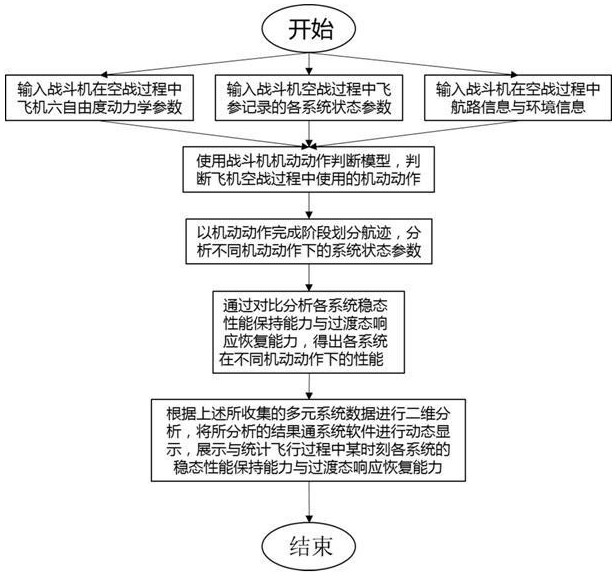A method for evaluating the steady-state and transition-state performance of each system under the maneuvering action of a fighter jet
A technology of maneuvering action and steady-state performance, applied in the field of fighter flight, can solve the problems that there is no systematic evaluation and analysis method and system, and achieve the effect of optimizing design and maintenance support
- Summary
- Abstract
- Description
- Claims
- Application Information
AI Technical Summary
Problems solved by technology
Method used
Image
Examples
Embodiment 1
[0029] This embodiment discloses the performance evaluation of each system of the aircraft based on the performance evaluation of each system of the aircraft during the air combat process, so as to realize the monitoring, evaluation and analysis of the performance of each system of the aircraft in the air combat mission, so as to optimize the design and maintenance guarantee of each system of the aircraft , and provide a basis for state change for the planning and execution of subsequent missions, so that pilots who perform missions can understand their advantages and threats during the mission, and better complete the combat missions of fighter jets. The specific process is as follows: figure 1 shown, including the following steps:
[0030] The first step is to input the aircraft speed, altitude, overload, pitch angle, yaw angle, roll angle and the actuation signals of each wing surface, vertical Tail and rudder surface actuation signals, engine signals and other key paramete...
Embodiment 2
[0036]On the basis of the above-mentioned embodiments, this embodiment further defines a method for evaluating the steady state and transition state performance of each system of the aircraft under the maneuvering action of the fighter jet. In the second step, a typical judging model for the maneuvering action of the fighter jet is used to analyze The input data, and then obtain the tactical and air combat maneuver information used by the fighter in the air combat process. Specifically, the aircraft route information is obtained, and the latitude and longitude, altitude, yaw angle, roll angle, and pitch angle are used as inputs to construct a six-degree-of-freedom maneuvering model of the aircraft. The establishment of the maneuvering action discrimination model, through the machine learning method based on the dynamic Bayesian network in the Python language in the Windows environment, realizes the identification and classification of maneuvering actions, and records the classi...
Embodiment 3
[0038] Based on the above embodiments, this embodiment further defines a method for evaluating the steady state and transition state performance of each system of the aircraft under the maneuvering action of the fighter. In the third step, the maneuvering action segment is used to divide the flight path. The division principle of maneuver segments will mark the start and end points of maneuvers in the voyage track according to the classification results of deep learning, name maneuver segments with typical maneuvers, and extract key flight parameter data in the segment. The other parts of this embodiment are the same as the above-mentioned embodiments, and are not repeated here.
PUM
 Login to View More
Login to View More Abstract
Description
Claims
Application Information
 Login to View More
Login to View More - R&D
- Intellectual Property
- Life Sciences
- Materials
- Tech Scout
- Unparalleled Data Quality
- Higher Quality Content
- 60% Fewer Hallucinations
Browse by: Latest US Patents, China's latest patents, Technical Efficacy Thesaurus, Application Domain, Technology Topic, Popular Technical Reports.
© 2025 PatSnap. All rights reserved.Legal|Privacy policy|Modern Slavery Act Transparency Statement|Sitemap|About US| Contact US: help@patsnap.com

